
Commuters in almost half of London’s most popular commuter towns face a greater overall financial burden from growing rents than from train fares.
Landbay’s Rental Index, powered by MIAC, found out of the capital’s 40 commuter belt hotspots, all in the East or South East of England, 17 towns saw their rail fares and average rents rise.
The average rents these towns rose by an average of £183 (1.68%) in the year to December, while rail fares have jumped by an average of £142 (3.6%). Combining these rents and rail costs, commuters in these regions face an additional £325 a year.
John Goodall, chief executive and founder of Landbay, said: “Commuters have seen their season ticket prices rise by more than £100 this week, the vast majority of whom are also looking at a double whammy of rent rises driven by greater tenant demand.
“At a time when rents in the capital are falling, some may even be considering a move into London, to be done with the train commute altogether.
“With inflation riding so high, rail fare growth shows no sign of slowing, and without a radical house building plan for purchase as well as purpose-built rental properties, rental price growth is expected to accelerate this year as well.”
Cambridge and Brighton have seen the greatest rise in rents, £228 (2.06%) and £202 (1.58%) respectively, as rail fares in both regions rose by £172 and £163.
A further 6 towns in London’s commuter belt saw rents rise by more than 1% in 2017, double that of the UK average.
Luton, Hastings, Basingstoke, Ashford, Canterbury and Horsham have seen rents rise by an average of £146, almost as much as the average £166 increase in rail fares.
Commuters living in Guildford, Reigate and Woking saw their rents fall by £127 (-0.73%) in 2017 so will be saving enough to offset the rail fare hikes of £126, £99 and £113 respectively.
Those in Aylesbury and High Wycombe (-£43) and Slough (-£4), have also made rent savings, but hardly enough to chip away at the £141, £124 and £91 increase to train fares.
There are now signs that demand for low-rent accommodation by long-distance commuters to London is pushing up rents in these areas.
Some 31 of the 40 most popular commuter routes have seen rents rise by more than the UK average of 0.56%, and by as much as 2.15% in Southend on Sea and 2.06% in Cambridgeshire.
Only Slough (-0.04%), Buckinghamshire (-0.31%) and Surrey (-0.73%) have seen rents fall, while Reading (0.03%) and Bracknell Forest (0.05%) have seen sub-average growth.
However in London rents fell by -0.80% in 2017, yet at, £1,872 they remain more than twice the £765 average across the rest of England.



